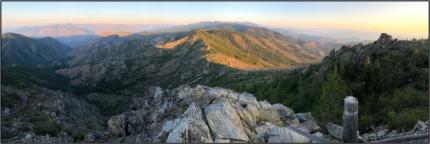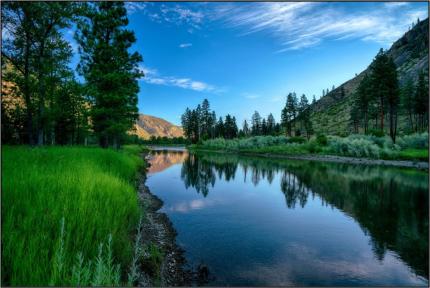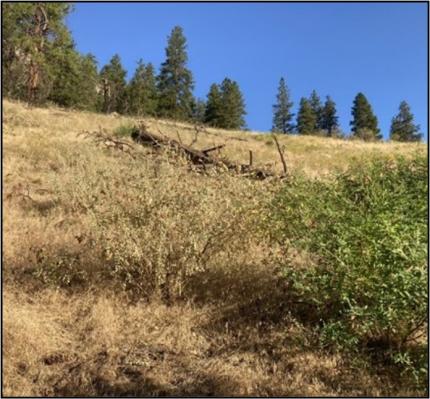Managing Wildlife Populations
Raptors: Biologist Eilers joined U. S. Fish and Wildlife Service and HawkWatch International (HWI) in transporting and setting up the seasonal HWI migration site on Chelan Ridge near Cooper Mountain. This site is one of HWI’s many long-term raptor migration monitoring sites, the purpose of which is to document species occurrence and abundance for all diurnal raptors migrating south to their wintering grounds.
“The primary objective of these efforts is to track long-term population trends of diurnal raptors throughout primarily western North America. The information gathered enables us to better understand the life histories, ecology, status, and conservation needs of raptor populations in North America. Raptors feed atop food pyramids, inhabit most ecosystems, occupy large home ranges, and are sensitive to environmental contamination and other human disturbances. Therefore, they serve as important biological indicators of ecosystem health. Moreover, due to the remoteness and widespread distribution of most raptor populations, migration counts likely represent the most cost-effective and efficient method for monitoring the regional status and trends of multiple raptor species.” -Hawkwatch International - Migration Network
The HWI Chelan Ridge site is open to the public for viewing and education – although 4WD or AWD is highly recommended to get there! But trust us, the panoramic views (and raptors) are worth it! If you have a group of six or more people, it is asked that you schedule your visit beforehand at HWI Migration Site Group/Extended Visit Schedule (jotform.com).




Bats: Biologists Jeffreys and Eilers wrapped up the bat monitoring season with a final emergence count at a U.S. Forest Service warehouse near Lake Wenatchee. Although well over a hundred bats had been counted here in July, few bats were observed exiting the roost on this second count. This suggests that juveniles are now self-sufficient and mothers and young can now freely disperse to other roosting sites for the remainder of the active season prior to hibernation.
A young Myotis bat was found sleeping on the main door of WDFW’s Wenatchee District Office during the day. This young male is likely still learning how to be a bat, and as he gets older and wiser, he will learn to choose safer, less-exposed roosting sites that afford better protection from predators and the elements. Biologists surmise this juvenile bat spent the night foraging on insects attracted to the flood light right outside the office and then tucked himself in for the day by the front door hinge. Using gloves, Biologist Eilers relocated the little bat to WDFW’s back warehouse where he could rest undisturbed before continuing his insect removal services after sundown.



Biologist Eilers is a trained and vaccinated professional. If you encounter a bat roosting low during the daytime, please leave it be. Watch the video at the link below for information on what to do if you encounter a bat in your home.
Sandhill Crane Update: Back in May, a state endangered pair of sandhill cranes successfully hatched two colts (baby cranes) in the Big Valley Unit of the Methow Wildlife Area. Around early July, a dedicated group of local volunteers, who monitor the cranes daily, reported one colt had disappeared, likely due to predation. Although, the good news is, as of Aug. 31 we have a fully-fledged juvenile crane flying strongly with mom and dad. The remaining juvenile is approximately 14 weeks old and was recently photographed by a local resident nearly six miles away (as the crane flies) at Twin Lakes, safely accompanied by the adults. Within the next few weeks, our trio of sandhill cranes will likely begin migrating to their wintering grounds in the Southwest. The juvenile is expected to be fully independent around ten months old, at which time it should join a flock of other nomadic juveniles until it hopefully forms a breeding bond between the ages of two and seven years old.
Fun Fact: Did you know, cranes are among the oldest living birds on earth and according to the Cornell Lab of Ornithology, the earliest unequivocal sandhill crane fossil is estimated to be 2.5 million years old.

Scotch Creek Bird Flight Diverters: Staff members worked with the Okanogan County Public Utilities staff members to have bird flight diverters and perch deterrents installed on the power lines and poles around the headquarters office. The riparian area shrubs adjacent to the office provides quality winter forage for sharp-tailed grouse and is frequently used by sharp-tails during the winter. Power lines are a collision hazard for sharp-tails and the diverters will make the lines more visible to sharp-tails.

Wildlife Surveys: Biologist Morris met with two landowners to review their Safe Harbor Agreements and site plans for the Columbia Basin pygmy rabbit. Morris and the landowners discussed what was included in their site plans, which provides the background of their property enrolled in the agreement and what activities on their land are covered under the Safe Harbor Agreement. These Safe Harbor Agreements in Grant and Douglas counties are very successful in protecting critical pygmy rabbit habitat while at the same time providing regulatory assurances to the landowners that the presence of pygmy rabbits won’t negatively affect their farming operations.
Pygmy Rabbit Release Effort Monitoring: Pygmy rabbit crew with the assistance of District 7 staff members and volunteers conducted monitoring for pygmy rabbit dispersal and burrow establishment on the Rimrock release area. We documented 12 likely active burrows, both in and outside of the release pens, with some fresh sign of rabbits up to 300 meters from the pens. Game cameras were set at some sites to confirm occupancy there. We will conduct similar monitoring on the Palisades release area soon.


Rattlesnake Issue: Over 10 years of pygmy rabbit work and we have run into very few rattlesnakes. This year however is very different. We have encountered them almost on a weekly basis in the release pens and have found at least three that were entangled in the fencing. We began looking into the burrows with our burrow camera and found them occupying the rabbit burrows. Not really seeing any benefit to this cohabitation, we have removed two rattlers from our rabbit pens this summer, releasing them miles away.


Providing Recreation Opportunities
Lake Lenore Target Shooting Range: Lands Operations Manager Finger drafted a grant proposal for the Lake Lenore Target Shooting Range for initial review, budget development, and consideration of cultural resource survey needs and budget.
Pheasant Release Meeting: Wildlife area staff members, district staff, and pheasant release staff had meeting concerning pheasant release numbers and dates. New steel shot area requirements were discussed as well, wildlife area staff will have to physically go out to new boundaries so they can be published in digitized format.
Rocky Ford Blind Repairs: Biologist McPherson and Specialist Walker had to go make repairs to Rocky Ford blind due to wind damage. Closer to season Biologist McPherson will schedule with Washington Waterfowler Association to brush in blind for the opening weekend.

Aeneas Lake Water Access Area Issues: An adjacent landowner to Aeneas Lake site had contacted complex Manager Haug over some issues at the site. Some concerns were people driving in tall grass down to the lake creating a potential fire risk and swimmers clogging the boat launch up for fishermen. We all met onsite and walked around assessing things. We came up with installing barrier rock where people were driving off road and a few other side roads to direct the public where to drive and installed some new signage by the boat launch. The contractor was contacted for estimates and timeline for job. He was able to fit us in rather quickly and get the job done in a timely manner.
Green Lake Access Area and Campground Project: Lands Manager Haug completed and submitted the Recreation and Conservation Office (RCO) application to improve the Green Lake water access and campground. The project will significantly improve campground facilities, access to the shoreline and provide better ADA components to the area. The preliminary evaluation of the project has it prioritized as three out of ten projects. At the most conservative funding level, the project would most likely get funded within the next state budget.
Hunter Access: Coordinating public access on private lands for hunting opportunities is one of the tasks private land biologists conduct. In support of this effort, Biologist Cook is working on updating a few hunter access contracts. All these contracts are currently active but need some updates.
Biologist Cook is working on implementing QR codes for hunters to use at register to hunt sites for this year. This is a continuation of work done last year and hopefully will allow for expansion of sites these will be available.
Biologist Morris met with a landowner that is enrolling approximately 700 acres in our Hunt by Written Permission Program. He went over details and expectations for this property that will be available to hunt (with permission) this fall. Biologist Morris also checked several properties to ensure signs were posted properly and in good condition before the start of hunting season.
Providing Conflict Prevention and Education
Nuisance Bear: Specialist Heilhecker called a landowner regarding a bear breaking limbs off her cherry tree. The landowner has dogs contained in a fence in her yard, but their barking does not always cause the bear to leave. They discussed nonlethal deterrence methods. Specialist Heilhecker also advised the landowner of her rights to protect her safety and her property. However, it was explained that bear hunting season is open if the landowner was interested in using a hunter to kill the bear so the meat and pelt would not be wasted.
Bear Call: Specialist Heilhecker called a homeowner who reported a bear getting into a garbage can on the front porch. The garbage can was moved to inside the garage. The homeowner stated she would notify others in the neighborhood to remove all attractants including bird feeders, pet food, and garbage.
Cougar Call: Specialist Heilhecker received a call from a livestock producer regarding missing calves. The producer believes a cougar has been taking his animals. There are no injured or dead animals to investigate. Since the livestock graze in GMU 204, the producer stated he may use tribal members to hunt cougars. Specialist Heilhecker reminded him to call if he finds any injured or dead livestock.
Reducing Deer and Elk Damage: Specialist Bridges continues to work with several landowners in assisting with efforts to decrease damage from deer and elk in tree fruit orchards.
Coordination with Local Municipality: Specialist Bridges is working with the City of Leavenworth Public Works director and various non-government organization’s to evaluate how to begin a community wide effort of reducing major attractants at garbage sites. Funding continues to be lacking, so conversations will continue to locate funding sources. An effort this large will take time to get going but early indications
Addressing a Chronic Bear Conflict Site: Specialist Bridges met with the City of Leavenworth’s Public Director to discuss fencing designs, permitting, and functionality of design with garbage pickup trucks.
Exclusion Fencing Construction: Specialist Bridges initiated and is coordinating a fencing project to exclude a domestic goat and sheep operation from an adjacent wild big horn sheep herd in order to reduce the potential of disease to the wild sheep. Specialist Bridges is working with the private landowner, Wild Sheep Foundation, and the Asotin County Conservation District. Work began on Aug. 25th and should take two to three weeks to complete.
Conserving Natural Landscapes
Region 2 North Acquisition Presentations: Lands Operations Manager Haug presented three acquisition projects in Okanogan County in two RCO categories: Critical Habitat and Riparian. The two critical habitat projects (ranking number five and six) protect approximately 900 acres of shrubsteppe habitat and the riparian project (ranking nine out of thirteen) protects nearly 70 acres across two properties adjacent to the Similkameen River. Funding will be determined when the budget passes next year.


Sinlahekin Wildlife Area Noxious Weeds: Sinlahekin staff members continued treating noxious weeds on many of the units that make up the Sinlahekin. Staff members spent a considerable amount of time treating bladder senna and multiflora rose on the Sinlahekin Unit. They covered most of the valley within the last few weeks hiking up and down the hillsides of the valley. They are continuing treatment and have started to go back through areas that were previously treated, finding plants that were missed.


Sinlahekin Wildlife Area Shared Stewardship: Manager Wehmeyer and Assistant Manager Riley also met with Prescribe Burn Program Lead Eberlein to develop a project area for a potential cross boundary project with the Department of Natural Resources (DNR). This initial meeting helped to determine the feasibility and potential for doing the project. The next step is for staff members to meet with the DNR and go over the project idea.
Scotch Creek Wildlife Area Noxious Weeds: Staff members continued treating musk thistle on the Chesaw Unit. Recent warmer weather has caused many of the apical terminal buds to flower. Staff members will continue their control efforts through the month of August, spot treating and hand pulling seed heads as necessary. Staff members continue to treat musk thistle on the Chesaw Unit. Most of the plants have reached maturity, requiring seed head removal. This year, staff members have hand pulled approximately 30, 15-gallon bags of seed heads. Staff members will continue efforts through the end of August.

Okanogan Lands 20/20 Project Submittals: Okanogan Lands Operations Manager Haug submitted five applications for acquisitions in Okanogan County. The projects protect critical shrubsteppe and riparian habitats and increase recreation opportunities in the area. The applications will be reviewed later this month and then presented to staff members in Olympia for approval.

SAFE-CRP: Biologist Cook completed additional paperwork for two SAFE-CRP contracts in Adams County and submitted them to Natural Resources Conservation Service (NRCS). These documents were entered into the NRCS system. Private Land Biologists in Region 2 provide technical assistance to landowners for them to comply with SAFE-CRP Farm Bill contracts. These contracts result in marginal farm ground being taken out of production and planted with species of native grass and forbs for upland wildlife habitat and erosion reduction.
Biologists Morris, Braaten and Cook conducted field visits with Biologists Braaten and Cook to evaluate newly enrolling SAFE-CRP fields to determine what management or alterations are needed to provide quality wildlife habitat over the course of the contract. A total of 14 SAFE-CRP plans are being developed in Douglas County.
Safe Harbor Agreement: Biologist Morris evaluated a Conservation Reserve Program (CRP) field that requires mid-contract management. The landowner contacted Biologist Morris because they have a Safe Harbor Agreement for pygmy rabbits, and the Natural Resources Conservation Service would like them to mow sagebrush in the field. Biologist Morris assessed the field for its potential to support pygmy rabbits, and after consulting with pygmy rabbit Biologist Gallie, will make recommendations for areas to leave the sagebrush intact to maintain pygmy rabbit habitat.
Habitat Plots: Working with private landowners to restore and enhance wildlife habitat is one aspect of the work we do. Biologist Morris met with a landowner that would like to do wildlife habitat improvements on his property. They discussed possible options and looked at the spring as when the landowner wants to develop and plant shrubs around. This same landowner wants to make alterations to an ephemeral stream bed that is dry most of the year, so Biologist Morris arranged a meeting between the landowner, Habitat Biologist Pentico, and Environmental Engineer Snodgrass. They discussed options for alteration that would maintain and/or improve the health of the stream and what was needed to acquire a permit.
Biologist Morris began planning a wildlife habitat improvement project for upland game that can hopefully be started this fall. The project would benefit upland birds, big game, and non-game upland wildlife and is located on property enrolled in our Hunt by Written Permission Program.
Conducting Business Operations and Policy
WDFW Staff and U. S. Border Patrol Meeting: Lands Operations Manager Haug, Regional Property Specialist Ramirez, Scotch Creek Manager Dupont, and Sargent McCormick met with U. S. Border Patrol staff members in Oroville to discuss the deployment of a border security communications tower on the Eder Unit. Staff members expressed their concerns with the project and the U. S. Border Patrol provided information regarding equipment and things they can do to minimize impacts on the wildlife area unit. Ramirez finalized the one-year agreement with the border patrol and staff members will work with the U. S. Border Patrol to make sure impacts are minimized with the addition of the tower.
Complying with Public Disclosure Request: Specialist Heilhecker completed a public disclosure request regarding landowner damage prevention cooperative agreements and landowner damage/kill permits.
Interview Panel Participation: Specialist Heilhecker participated in interviews for new Wolf Advisory Group members. To date, they have interviewed 11 candidates for five positions. Additional interviews will be held in September.
Meeting With Partner Organizations: Biologist Morris attended the Columbia Basin Pheasants Forever Board Meeting. The Columbia Basin Conservation District (formerly Grant County Conservation District) also had a representative in attendance. In this meeting, potential opportunities for the three organizations to collaborate on habitat projects were discussed.
Other















